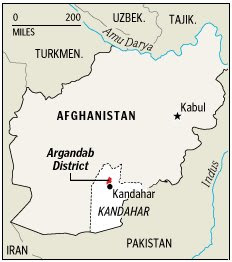Arghandab ambiguity
Confusions abound in the reporting of recent events in Arghandab district in Kandahar province.
From the Guardian:
Afghanistan: Kandahar braces for Taliban attack as thousands fleeBut NATO claims otherwise:
June 17 -More than 4,000 people have fled villages near Kandahar in southern Afghanistan after Taliban forces destroyed bridges and laid mines in a major show of force.
In anticipation of a Taliban attack, the Afghan army today flew four planeloads of soldiers to Kandahar from the capital, Kabul. Canadian forces have also moved in to the region...
Thousands have fled the area, said Sardar Muhammad, a police officer manning a checkpoint on the east side of the Arghandab river. Police stopped and searched every person passing on the road. On the west side of the river, hundreds of Taliban controlled around nine or 10 villages, Muhammad said...
One of the Afghans fleeing Arghandab said families were being forced out just as grape groves needed harvesting, meaning financial ruin for thousands. Haji Ibrahim Khan said Taliban fighters were moving through several Arghandab villages with weapons on their shoulders, planting mines and destroying small bridges.
"They told us to leave the area within 24 hours because they want to fight foreign and Afghan troops," Khan said. "But within a week we should be harvesting, and we were expecting a good one. Now with this fighting we are deeply worried the grapes are the only source of income we have." ... (link)
NATO's International Security Assistance Force and the U.S.-led coalition offered a strikingly different picture of the Arghandab region than the one portrayed by Afghan officials. The U.S.-led coalition said in a statement that it had sent a patrol through Arghandab that met no resistance. (link)Earlier, NATO spokesperson General Carlos Blanco dismissed as "nonsense" claims that Taliban were poised to take over Arghandab.
Reuters:
Ahmad Wali Karzai, the head of Kandahar's provincial council and a brother of President Hamid Karzai, said about 600 Taliban had positioned themselves in Arghandab district, which lies 20 km (12 miles) to the north of Kandahar city, one of Afghanistan's largest cities. He did not know if the militants included the 400 set free in the jailbreak.Veteran AP reporters Noor Khan and Jason Straziuso, apart from relaying NATO skepticism as we saw above, have a slightly different take on civilian evacuations:
NATO and Afghan forces have deployed troops to seal off the area to drive the militants from the district, which has an estimated population of 150,000. NATO troops have dropped leaflets by air warning people to leave the district, fleeing villagers said... (link)
In The New York Times, Carlotta Gall cites a tribal elder who says the Taliban have taken as many as 18 villages. The Washington Post says seven. According to Reuters, the Afghan government says it is eight villages.NATO aircraft, meanwhile, dropped leaflets in Arghandab telling residents to stay in their homes — even though the Afghan Defense Ministry was telling them to leave.
"Keep your families safe. When there is fighting near your home, stay inside," NATO spokesman Mark Laity quoted the leaflet as saying.
Despite that message, more than 700 families — perhaps 4,000 people or more — fled Arghandab, said Sardar Mohammad, a police officer at a checkpoint on the east side of the Arghandab River.
On the west side of the river, hundreds of Taliban controlled about nine or 10 villages, Mohammad said.
"Last night the people were afraid, and families on tractors, trucks and taxis fled the area," he said. "Small bridges inside the villages have been destroyed."
The Ministry of Defense — which rushed in some 700 Afghan soldiers — said insurgents got close to a police checkpoint in Arghandab and asked the police to "join them." The ministry said the fact the militants had to use a translator shows that foreign fighters were behind the assault.
Haji Agha Lalai, a provincial council member, said the militants were destroying bridges and planting mines in hopes of repelling attacks from Afghan and NATO forces.
"From a strategic military point of view, Arghandab is a very good place for the Taliban," he said. "Arghandab is close to Kandahar city, allowing the Taliban to launch ambushes and attacks more easily than any other place in the province. Secondly, it's covered with trees and gardens — they can easily hide from airstrikes." ... (link)



No comments:
Post a Comment